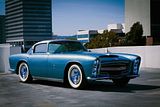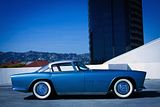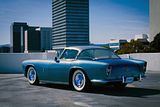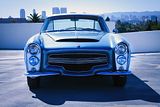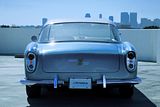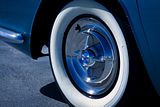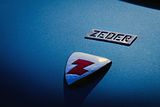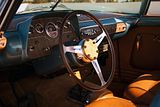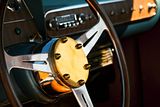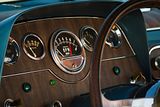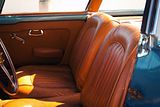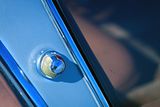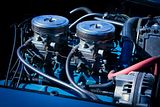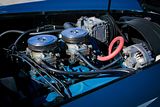The Dodge Storm Z-250 was developed by Chrysler engineer Fred Zeder to evaluate the feasibility of producing a vehicle that would capture a portion of the growing American sports car market. Built on a rigid tube frame chassis, it was intended to be a dual-purpose sports / racing car. When raced, the comfortable touring body currently fitted could be removed by Unscrewing four bolts and Replaced with an ultra light 150-pound fiberglass body. The Storm did not reach production because high production costs would have made it too expensive to sell in profitable quantities. If produced, the Dodge Storm Z-250 would have competed with the Ford Thunderbird, Chevrolet Corvette, and Kaiser-Darrin. This Forgotten Car Should Have Been Chrysler's CorvetteJalopinik Máté Petrány 4/03/13 What if I told you Chrysler had a modern two-seater sports car pretty much ready for production right at the time when the first Chevrolet Corvette came out, and a year before Ford introduced their record-selling Thunderbird? Well, I'm telling you that now. I saw a picture of this car once and all I knew was that it's a Dodge from 1953 with a Bertone body. But after reading the article #142 (July/August 1994) issue of Special Interest Autos Magazine I found in Hemmings Blog, I can tell you much more about it. It starts with the name. While some call it the Dodge Storm or a Bertone, it is actually the Zeder Z-250 (just when you thought Nissan made "Z" cars). The sports car was created by Fred Zeder Jr., son of Frederick Zeder of The Three Musketeers, the engineering team that started the Chrysler Corporation. If you don't know the badge, don't worry, although the Z-250 was not even the first Zeder. Thirty years back, Zeder, Skelton and Breer designed a car with a high compression engine and four hydraulic brakes. That reached production as the Chrysler Six, the first modern automobile after Ford's Model T. The younger Zeder had an engineering degree himself, but in 1951, he was working in advertising in New York as vice president of McCann-Erickson. He was also a keen racing driver, and after competing against Briggs Cunningham using a Chrysler Allard, he decided it was time to make a dual-purpose sports car that can outrun not only Cunninghams, but Ferraris and Jaguars as well. He certainly got the connections to start a project of this kind even after his father's death in February 1951, as Carl Breer – who kept working as a consultant for Chrysler after his retirement in 1949 for another four years – was his uncle. Zeder's idea was that two cars should be made using a common platform: a two seater race car with a fiber glass body weighting only 150 pounds, and a luxurious aluminum coupe. The bodies were to be easily swappable by using four rubber-bushed nuts, where the performance remained the same in both forms. The Z-250 used a modified version of the Dodge HEMI V8 truck engine, which produced 260 horsepower and about 330 ft-lbs of torque according to this article. That propelled the car from 0-60 mph in about 7.5 seconds, and the quarter mile took just 14.7 seconds. Other parts like the brakes, radiator, clutch, steering, rear axle, fuel tank and electronics came from the shelves of Plymouth and Dodge. The rest like the tube space frame, the suspension and the two bodies were unique to the car, while the transmission was a brand new unit developed by the Spicer Division of Dana Corporation. Since he was aiming for a late 1954 launch, Fred went into partnership with Gene Cassaroll, a fellow racing enthusiast and owner of Automobile Shippers Inc, the company that hauled Chrysler's products all across the country. They founded the Sports Car Development Corporation, while Zeder also got John Butterfield onboard, who used to work for Cunningham and was one of Chrysler's top chassis engineers at the time. Most of the development took place in his basement in Detroit. The styling was the work of Hank Kean, who also happened to be a Chrysler employee. When the quarter-scale clay model was ready, Virgil Exner, Chrysler's Head of Advanced Design also had some suggestions. When not in the basement, he was working with Ghia on Chrysler's future. But when Zeder went to see Fiat's Chief Engineer in Turin during his Christmas vacation in 1952, Dante Giacosa directed him to Bertone instead. They were pretty busy with Alfa Romeo's BAT series, so it took 9 month instead of the promised 3 to finish Zeder's car. Italiano. Bertone also turned it into a two-seater instead of the planned 2+2, because what worked on paper turned out to be impossible in reality. The car was then taken to Fiat's famous oval roof track for fine tuning, after which the Z-250 took first price at the Turin Auto Show. It was then shipped to New York onboard of the SS Andrea Doria (which sunk three years later after a collision with MS Stockholm). After picking it up at the docks, Zeder parked it in front of the Rockefeller Center, which resulted in such a massive traffic jam that the police had to ask him to move it. In April 1954, Fred took his pride (now called the Storm Z-250) to Chrysler's design headquarters in Hamtramck. After his father's death, his uncle Jim Zeder became the Chief Engineer. He was trained for years by the old trio to not be supportive when it came to new ideas. He borrowed the car so Chrysler could evaluate it, but instead he locked it up in the factory's storage for two years, under which nobody was supposed to touch or even mention the car. Fred's guess was that Jim feared he wouldn't get any credit if it succeeded, but would take the heat if it failed. The official reason was that the car was too expensive to produce in order to sell it in profitable quantities. By the time Fred got back his car, people were driving Corvettes and brand new Ford Thunderbirds, not to mention Nash-Healeys, Kaiser-Darrins, and Cunninghams on the tracks. Just like the Oldsmobile or Pontiac "Corvettes," Chrysler's was killed as well before it could prove itself. Zeder drove the Z-250 for 16 years before he donated it to the Northwood University. It stayed in the museum until 1992, when he picked it up again. Since somehow water leaked into the cylinders during its sleep, it had to be restored with a 1965 Dodge V8 with two four-barrel carburetors before he could enjoy it again in his home in California. Recently, it was exhibited at the Petersen Automotive Museum among other American-Italians. The next time Chrysler made a real sports car was in 1992. Massive hat tip to Michael Lamm who covered the story in 1994. |
|


